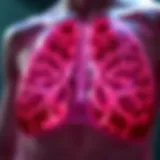Understanding Dialysis Risks: A Detailed Overview


Intro
Dialysis serves as a vital lifeline for many individuals grappling with renal failure. The procedure steps in when kidneys have thrown in the towel, unable to filter waste from blood effectively. While the life-saving benefits of dialysis can't be overstated, it’s also crucial to navigate the potential pitfalls that accompany the treatment. Understanding these risks is not merely academic; it impacts patient quality of life, treatment adherence, and overall health outcomes.
The complexities surrounding this subject warrant a deep dive. Both patients and healthcare providers must be aware of physical, psychological, and dietary complications that can surface, alongside preventive measures that can help mitigate these stressors. In a world where medical advancements dictate health pathways, staying informed is key.
Overview of Research Topic
Brief Background and Context
Dialysis, developed decades ago as an alternative to kidney transplantation, primarily falls into two categories: hemodialysis and peritoneal dialysis. While the technology has evolved, the risks associated with treatment often remain consistent. From complications during the treatment process to emotional challenges post-dialysis, every aspect can significantly influence a patient's life.
Importance in Current Scientific Landscape
As chronic kidney disease rises globally, understanding the risks and implications of dialysis has never been more relevant. The interplay of patient safety, treatment efficacy, and overall quality of life provides a rich area for ongoing research and dialogue. Without addressing these risks, healthcare providers may be overlooking essential components of patient care.
Methodology
Research Design and Approach
The current analysis pulls from both qualitative and quantitative studies encompassing multiple patient demographics and health conditions. This multifaceted approach allows for richer insights into how risks manifest and their long-term consequences. We adopt a systematic review to summarize available literature and offer practical perspectives based on the latest findings.
Data Collection Techniques
Data is drawn from various sources: peer-reviewed journals, patient surveys, and healthcare provider interviews. Mixing both clinical data and personal anecdotes creates a well-rounded sense of the dialysis experience.
"Informed patients are empowered patients; understanding the risks associated with dialysis can make a world of difference in their treatment journey."
Ultimately, this detailed look not only strengthens our understanding but serves as a resource for anyone involved with dialysis.
In this article, we will delve into the specific risks that dialysis patients face, laying the groundwork for effective strategies to mitigate these risks.
Prelims to Dialysis and Its Necessity
Dialysis has become a lifesaving treatment for individuals dealing with severe kidney dysfunction. The kidneys are vital organs that perform numerous essential functions. They filter out waste and excess fluid from the blood, manage electrolyte levels, and also contribute to blood pressure regulation. When these organs fail, typically due to chronic diseases like diabetes or hypertension, dialysis steps in to take over some of these critical responsibilities. It is an urgent remedy that can mean the difference between life and death, hence its necessity in modern medicine.
Overview of Kidney Function
To appreciate the role of dialysis, one must first understand kidney function. The kidneys are bean-shaped organs located on either side of the spine and are responsible for cleaning the bloodstream. They remove toxins such as urea and creatinine, which accumulate from metabolic processes. Additionally, kidneys help maintain a delicate balance of electrolytes—such as potassium, calcium, and sodium—which is crucial for cellular function.
For example, when the kidneys are functioning normally, they automatically adjust for varying intake of nutrients, ensuring the body stays within healthy parameters. When damage occurs, whether from conditions like polycystic kidney disease or acute injuries, this regulation falters. Hence, the body potentially faces problems like fluid retention, high blood pressure, and electrolyte imbalances.
When Dialysis Becomes Essential
Understanding when dialysis becomes necessary can sometimes be tricky. Kidney failure doesn't happen overnight; it usually develops over time. A patient may experience gradual loss of function, and the decision to start dialysis often arises when the kidneys are functioning at less than 15% of their capability. This stage is known as end-stage renal disease (ESRD).
Dialysis comes in two principal forms: hemodialysis, which uses a machine to clean the blood outside of the body, and peritoneal dialysis, which uses the lining of the abdomen as a natural filter.
“Dialysis is not just a symptom of kidney failure; it's a critical lifeline that keeps many individuals alive.”
The initiation of dialysis can be a pivotal moment, often eliciting a mix of emotions ranging from relief to anxiety. Patients must adjust to new lifestyle choices, including dietary restrictions and regular treatment sessions. The necessity of this procedure cannot be understated, as it not only sustains life but also significantly improves the quality of life for many individuals grappling with the physical challenges posed by kidney failure.
In summary, dialysis provides critical interventions in cases of kidney function loss. This understanding lays the groundwork for a more detailed exploration of the various risks associated with dialysis in later sections.
The Types of Dialysis Procedures
Understanding the different types of dialysis procedures is vital when exploring the risks associated with dialysis treatment. Each method possesses its own set of procedures, benefits, and potential complications. Knowledge of these types aids both patients and caregivers in making informed decisions rooted in medical insights and personal preferences.
Hemodialysis Explained
Hemodialysis is one of the most common forms of dialysis. It involves the use of a machine to filter waste, minerals, and fluid from the blood. Typically performed in a dialysis center or hospital, this process usually runs three times a week, each session lasting around three to five hours.
The procedure works as follows:
- Access Point: Firstly, a vascular access point is needed. This can be through a fistula (connection between an artery and a vein), a graft, or a catheter.
- Blood Circulation: Blood is drawn from the body, passed through a dialyzer that filters impurities, and then returned to the body.
- Fluid Removal: During the session, excess fluid is removed, which is especially important for patients struggling with fluid overload.
While effective, hemodialysis does come with its own risks. For example, infection at the access site is a significant concern, alongside low blood pressure and muscle cramps during treatment. Patients might also experience fatigue and weakness following a session. It's crucial for patients to be aware of these potential issues and engage in regular consultations with healthcare providers to navigate these challenges.
Peritoneal Dialysis Overview


Peritoneal dialysis offers an alternative for those who cannot undergo hemodialysis or prefer to do their treatments at home. This method utilizes the lining of the abdominal cavity, known as the peritoneum, to filter blood. Unlike hemodialysis, which is more machine-dependent, peritoneal dialysis allows for increased flexibility and autonomy.
The process can be done in two main forms: continuous ambulatory peritoneal dialysis (CAPD) and automated peritoneal dialysis (APD).
How it operates:
- In CAPD, patients manually fill the abdomen with dialysate (a special fluid) and let it dwell for a few hours before draining it out. This cycle can be done multiple times a day.
- In APD, a machine automatically does the exchanges while the patient sleeps.
This type of dialysis carries its own risks, such as infection in the abdominal cavity (peritonitis), and can cause weight gain due to fluid retention. Patients may also experience abdominal discomfort or changes in their blood sugar levels. Once again, awareness and self-management are key components in reducing these risks. Regular monitoring and maintaining a clean environment can significantly help ensure better outcomes.
"Knowledge is power, specially when it comes to managing your health and making crucial decisions regarding treatments."
Both hemodialysis and peritoneal dialysis offer life-saving potential, each with their own set of benefits and challenges. Ultimately, the right choice often depends on individual health conditions, lifestyle, and preferences. As such, discussing options comprehensively with healthcare providers can lead patients to make the best choices tailored to their unique situations.
Physical Risks in Dialysis Treatment
Dialysis is a lifesaving therapy for patients with severe kidney dysfunction; however, it does not come without its own set of risks. Understanding the physical risks associated with dialysis is crucial for anyone involved in renal illness management—be it patients, caregivers, or health professionals. This section dives into the intricacies of such risks, illuminating potential complications and considerations that are essential to address. Ensuring awareness of these challenges can foster better management and improve patient outcomes. Furthermore, comprehending these risks enables healthcare providers to implement strategies that mitigate the negative consequences of dialysis treatments, ultimately safeguarding patient health and well-being.
Infection Risks at Access Sites
When patients undergo hemodialysis, they need reliable access to their bloodstream. This typically comes through a fistula, graft, or catheter. Each type of access can serve its purpose, but they are also hotspots for infection.
Infections at access sites can range from mild to severe. In simple terms, when the skin barrier is broken (as is the case with needles used during dialysis), there’s a risk that bacteria can invade. A common bacterium named Staphylococcus aureus often shows up in these situations. Such infections can lead to a more widespread infection known as sepsis, which is life-threatening.
- Symptoms to watch for:
- Swelling or redness around the access site
- Increased warmth or tenderness
- Fever or chills
To minimize infection risks, strict hygiene practices should be followed at all times. This includes cleaning the skin properly before access, wearing gloves, and, of course, ensuring that any equipment is sterile. Given the serious nature of these infections, it’s vital that patients are educated on these risks and the importance of monitoring their access sites.
Cardiovascular Complications
Patients on dialysis often possess a higher risk of cardiovascular disease. This association stems from various factors like fluid overload, electrolyte imbalance, and the accumulation of toxins that the kidneys can no longer filter.
The heart can endure considerable strain during dialysis. Many patients experience fluctuations in blood pressure, which can lead to conditions such as arrhythmias or even heart attacks.
- Additional factors contributing to cardiovascular risk include:
- Anemia: Common in dialysis patients and often leads to heart complications.
- Mineral Bone Disorder: Disrupts calcium and phosphorus balance, adding more burden on the heart and vasculature.
It is crucial for patients to work closely with their healthcare team to monitor not only their kidney function but cardiovascular health as well. Regular screenings and assessments can help in identifying potential issues before they become gravely serious.
Fluid and Electrolyte Imbalance
One major function of the kidneys is maintaining balance of fluids and electrolytes in the body. Dialysis takes over some of these roles, but not always effectively. This can lead to fluid build-up or electrolyte imbalances.
When too much fluid accumulates, patients may suffer from symptoms such as shortness of breath, swelling in different body parts, or sudden weight gain.
Moreover, important electrolytes such as potassium, sodium, and phosphorus require close monitoring. An imbalance—especially elevated potassium (hyperkalemia)—can lead to severe heart-related issues including cardiac arrest, which can be fatal.
- Preventive measures include:
- Monitoring weight changes between sessions.
- Adhering to dietary restrictions that limit intake of fluids and certain electrolytes.
Psychological and Emotional Challenges
Psychological and emotional challenges are more than just footnotes in the narrative of dialysis treatment. They carry significant weight, affecting patients' overall well-being and compliance with their treatment regimens. Understanding the mental and emotional state of patients undergoing dialysis is crucial, as it intertwines directly with physical health outcomes. Many individuals grapple with anxiety and depression, stemming from the chronic nature of their condition, the treatment schedules, and the uncertainties of their health. Moreover, these emotional issues can make navigating health journeys feel like hiking up a steep mountain without adequate gear, leading to burnout, frustration, and reduced quality of life.
To address these challenges, healthcare professionals must integrate mental health support into dialysis programs. This can range from pre-treatment counseling to ongoing psychological support, ensuring that patients feel validated in their experiences. By doing so, you're not just treating symptoms; you’re tending to the whole person.
Impact on Mental Health
The impact of dialysis on mental health can be profound and long-lasting. Patients may experience fluctuations in moods, which may sometimes be mistaken for mere fatigue or frustration with the treatment process. Understanding this connection is essential, as untreated mental health issues can lead to drastic changes in adherence to treatment protocols. The weight of the issues can be heavy, often resulting in:
- Increased levels of anxiety surrounding appointments.
- Feelings of helplessness due to dependence on machines.
- Stress associated with lifestyle changes imposed by dietary restrictions and travel limitations.
Clinicians need to recognize these mental health challenges, as they could directly affect treatment outcomes. For instance, a patient overwhelmed with anxiety may miss appointments, which could lead to dire consequences regarding their kidney health. Conversely, those with supportive coping strategies may navigate their treatment more successfully.
Social Isolation and Support Systems


Social isolation is another significant emotional risk for patients on dialysis. As their treatment requirements grow, so does the time commitment, often leading to a withdrawal from social activities. This change can feel like being thrown into a sea of loneliness. Friends and family might not fully grasp the strain of dialysis, leading to a natural drift in relationships.
Support systems play a pivotal role in how well one copes with these challenges. Effective support can come from:
- Family: Understanding and appreciating the patient's struggles can create a cushion of support.
- Support Groups: Connecting with others facing similar challenges often helps relieve feelings of isolation. These groups can be found through online platforms like Reddit or local community services.
- Healthcare Providers: Ongoing communication with medical professionals can provide reassurance and guidance.
Feeling isolated can exacerbate feelings of despair, while a strong support network aids recovery. For individuals going through dialysis, fostering connections and seeking support can transform treatment experiences, allowing them to become active participants in their care instead of passive recipients.
*"It's not the situation, but how we view it that changes everything."
— A subtle reminder of the power of perspective during challenging times.*
Mental health considerations are vital in shaping holistic treatment approaches. Both emotional states and social connections can significantly influence overall treatment satisfaction and health outcomes. By normalizing conversations surrounding these aspects, patients may feel more empowered to address their mental well-being head-on.
Nutritional Risks and Dietary Management
Managing dietary needs is essential for patients undergoing dialysis. As the kidneys are unable to perform their filtering functions, dietary choices become critical in ensuring the patients' overall health. Poor nutritional habits can lead to complications that may exacerbate the already existing risks associated with dialysis. Thus, understanding and managing nutritional risks is not just beneficial but necessary for anyone receiving this treatment.
Dietary Restrictions for Dialysis Patients
Dialysis alters the body's needs, and certain foods can interfere with treatment or contribute to further health complications. Patients often face various restrictions that may feel frustrating or overwhelming.
- Protein Intake: While proteins are crucial for maintaining body functions, their intake must be regulated carefully. Different types of dialysis—such as hemodialysis or peritoneal dialysis—have varying protein needs. Hemodialysis patients usually require higher protein due to the loss during treatments. Hence, it’s essential to focus on high-quality protein sources like lean meats, fish, or eggs.
- Sodium: Excessive sodium can lead to fluid retention and hypertension, complicating heart health. Patients are encouraged to eat fresh foods and limit processed ones, which often contain hidden salt.
- Potassium and Phosphorus: When kidneys fail, managing potassium and phosphorus levels becomes pivotal. High levels can lead to cardiac issues. Foods like bananas and tomatoes are high in potassium, while dairy and nuts contain phosphorus. A dietician usually suggests alternatives that help strike a balance.
Each patient’s requirements may vary, so personalized dietary guidelines from healthcare professionals play a crucial role in managing these restrictions effectively.
Risk of Malnutrition
Malnutrition remains a significant risk for dialysis patients owing to complex dietary restrictions. A plethora of factors contribute to this risk, including:
- Food Availability: Sometimes, access to suitable food can be a barrier, particularly for those living on limited incomes. This situation often leads to poor dietary choices that are convenient yet lacking in essential nutrients.
- Appetite Suppression: The dialysis process can alter taste perception, leading to a diminished appetite. Consequently, individuals may consume fewer calories than needed.
- Chronic Inflammation: Inflammation associated with kidney disease can affect nutrient absorption, further complicating dietary management.
Malnutrition can manifest in various ways—from fatigue to impaired immune response—significantly affecting patients' well-being. It’s crucial to monitor nutritional status continuously and make necessary adjustments to diet, aiming to improve patients' strength and resilience. Regular meetings with a dietitian can empower patients by providing them the knowledge to manage their diets better and fend off the risks of malnutrition.
"Regular dietary assessments are as important as any physical examination for patients in dialysis."
Long-Term Risks of Dialysis
When one embarks on the journey of dialysis, often the immediate focus settles on the pressing need to mitigate kidney failure. Yet, as time elapses, the larger picture unfolds, and long-term risks come into sharper focus. Understanding this facet of dialysis is crucial, not only for patients but also for healthcare providers and caregivers. Recognizing the potential long-term implications aids in informed decision-making and better management strategies, ultimately fostering a better quality of life.
As patients continue on dialysis, it's not only about the regular sessions but what happens beyond those walls. The treatment’s toll may echo throughout the body, leading to serious complications that can affect overall health. Given that dialysis is typically a long-term solution, awareness about the risks becomes paramount. This discussion revolves around two significant risks related to long-term dialysis: bone health complications and increased cancer risk.
Bone Health Complications
One of the most concerning long-term risks associated with dialysis is the impact on bone health. Patients often experience a condition known as renal osteodystrophy. This disorder arises due to an imbalance in minerals and hormones that are regulated by healthy kidneys. Essentially, when kidneys fail, several vital processes break down, leading to higher phosphate levels in the blood, while calcium levels tend to drop.
Consequences of this may include:
- Weakening of bones: With impaired minerals, bones can become brittle and frail, increasing the risk of fractures.
- Pain and discomfort: Patients may also experience generalized bone pain that interferes with their daily activities.
- Altered growth and deformities: In some cases, especially among younger patients, there may be issues with growth, leading to deformities in bone structure.
Apart from adjusting dietary intake, medications like phosphate binders and vitamin D supplements are often necessary. Regular monitoring of blood levels is crucial to make timely adjustments in treatment plans. Understanding the vital interplay between diet, medication, and bodily functions can help patients manage these bone-related risks more effectively.
Increased Risk of Certain Cancers
Dialysis can also cast a long shadow concerning cancer risk. Studies suggest that patients undergoing long-term dialysis may face an elevated risk of various cancers, especially those related to the kidneys and urinary system, but the implications can extend even further.
Factors contributing to this increased risk include:
- Weakened immune system: Dialysis patients often have compromised immune responses, which can make it harder for the body to fend off cancers.
- Chronic inflammation: The ongoing inflammatory state caused by kidney failure and dialysis plays a significant role in cancer development. This inflammation may be a catalyst for changes in cellular structures over time.
- Exposure to carcinogens: Long-term exposure to certain substances during dialysis can also pose risks, leading to potential malignant transformations at a cellular level.
Thus, continuous awareness and vigilance are recommended in patients undergoing dialysis. Monitoring for any unusual symptoms and regular screenings for various cancers can enable early detection, which is crucial for successful intervention.
"The complexities of dialysis don't just dissipate with each session; they linger, shaping the patient's journey in profound ways."
In summary, the long-term risks related to dialysis present both a dilemma and an avenue for preventive measures. Through lifestyle adjustments, healthcare vigilance, and patient education, it’s possible to tackle these challenges head-on. Ultimately, patients, their families, and healthcare professionals must work in tandem to navigate this intricate landscape.
Preventive Measures and Risk Mitigation
In the realm of dialysis, where the stakes can be high, understanding how to mitigate risks is not just helpful; it can be life-saving. Preventive measures are akin to the guardrails along a treacherous mountain road. They might not make the journey smooth, but they certainly help keep one on the right track. This section looks at the essential strategies patients and healthcare professionals can employ to ensure safety and enhance treatment success.


Regular Monitoring and Follow-Up
The heartbeat of effective dialysis treatment lies in regular monitoring and follow-ups. Just like checking the oil in a car regularly prevents breakdowns, consistent health assessments can significantly reduce complications associated with dialysis. This involves routine blood tests to assess kidney function and electrolyte levels, adjusting treatment as necessary. Patients should understand the significance of their lab results, as this knowledge empowers them to take charge of their health.
- Types of Monitoring:
- Follow-Up Schedules:
Establishing a consistent follow-up schedule with healthcare providers ensures that any arising issues are caught early, and adjustments to treatment can be made promptly. This might include:
- Blood Tests: Key indicators like urea and creatinine levels help track the efficiency of dialysis.
- Weight Checks: Sudden weight gain or loss can signal fluid retention or dehydration.
- Vital Signs: Regularly checking blood pressure and heart rate is essential to catch potential issues early.
- Monthly assessments for stable patients.
- Bi-weekly or weekly visits for those experiencing complications.
"An ounce of prevention is worth a pound of cure."
This adage rings especially true in the context of dialysis care. Regular monitoring is an essential key to unlocking better health outcomes.
Patient Education and Self-Management
Equipping patients with knowledge about their treatment forms the foundation of self-management. It’s not merely about following instructions but about understanding the why behind each step. When patients are well-informed, they are better positioned to manage their health proactively.
- Key Topics for Education:
- Self-Management Strategies:
- Understanding Dialysis: Patients should have a solid grasp of how dialysis functions and its significance. Knowledge helps in alleviating anxiety concerning the treatment process.
- Dietary Guidance: An effective dietary plan can make a remarkable difference. For instance, knowing how to balance protein intake, potassium, and phosphorous is crucial for health maintenance.
- Recognizing Symptoms: Patents should be trained to identify signs of complications, such as redness at the dialysis access site, which could indicate infection.
- Medication Adherence: Keeping a medication diary can help manage prescriptions effectively.
- Lifestyle Modifications: Encouragement to stay active, avoid smoking, and limit alcohol can have profound impacts on overall health.
- Support Groups: Engaging with peers can help share experiences and tips for navigating the challenges that come with dialysis.
By fostering an environment of continual education and support, institutions can enhance patient resilience. Ultimately, well-informed patients are less likely to experience complications, which makes a strong case for prioritizing education during patient care.
Innovations and Future Directions in Dialysis
Exploring advancements in dialysis is crucial as these innovations have the potential to reshape treatment outcomes for countless patients. The landscape of nephrology is evolving rapidly with new technologies aimed at enhancing the efficacy and convenience of dialysis. Such advancements not only promise to lessen the physical burden on patients but also address some of the pressing complications associated with traditional methods.
Technological Advancements
Recent developments in dialysis equipment and procedures are transformative. One noteworthy advancement is the integration of wearable technology. Devices now allow real-time monitoring of vital signs and fluid levels, giving patients and healthcare providers better oversight of health status. This proactive approach reduces the risk of complications and spikes in critical factors such as blood pressure and electrolyte levels.
Moreover, innovations in hemodialysis machines are aimed at improving efficiency. These machines now utilize more sophisticated filtration processes that can better mimic kidney function, resulting in improved clearance of toxins. Some manufacturers are also investing in modular designs that allow for easier transport and set-up, making it possible for patients to receive treatment in home settings rather than being tethered to a clinical facility.
Additionally, the growth of online hemodiafiltration is a promising development that combines benefits from both hemodialysis and peritoneal dialysis. By utilizing high volumes of dialysate, this method enhances the removal of larger molecular weight toxins. The ongoing research and implementation of such advanced techniques demonstrate that the future of dialysis is not only about treating kidney failure but also about improving life quality.
Research on Dialysis Alternatives
As medical research advances, so too does the exploration of alternatives to traditional dialysis treatments. One area generating significant attention is regenerative medicine, particularly the development of bioengineered kidneys. Researchers are working diligently to create artificial kidneys that can perform all functions of natural kidneys, potentially eliminating the need for dialysis altogether.
Another promising avenue involves the use of stem cells to support kidney function. Studies show that stem cells could facilitate regeneration of damaged renal tissues, reducing dependence on dialysis. While this field is still in its infancy, early results are encouraging and hint at a future where chronic kidney disease may be managed more effectively.
Additionally, there is a growing interest in portable dialysis units. Such devices allow patients more freedom and flexibility, enabling them to engage with their day-to-day lives while receiving treatment. This shift towards home-based and portable dialysis systems reflects an understanding of patient needs and lifestyles, ultimately leading to improved adherence and outcomes.
"Innovative research and technology are paving the way for a future where individuals with renal failure can lead more active and fulfilling lives."
Considering these advancements, it's evident that the future of dialysis encompasses more than just ongoing treatment; it involves empowering patients, minimizing risks, and enhancing quality of life. As technology progresses and research continues, the dialysis community remains focused on creating solutions that address the multifaceted challenges posed by kidney failure. This continuous improvement highlights the necessity for ongoing support, research funding, and collaboration within both the medical community and patient advocacy groups. In essence, the journey toward better dialysis—and potentially kidney replacement—has never been more promising.
Ending: The Complex Landscape of Dialysis Risks
The topic of dialysis risks is not just a clinical issue; it’s a profound health concern that resonates deeply with patients and their families. Far from being a straightforward treatment process, the reality of dialysis involves navigating a web of physical, emotional, and nutritional challenges. This conclusion serves to encapsulate the multifaceted risks associated with dialysis, providing a framework for understanding and addressing them.
Many think of dialysis solely in terms of its life-sustaining function, but it’s necessary to look beneath the surface. Each treatment session brings potential complications ranging from cardiovascular issues to dietary restrictions. The weight of these risks often creates a layered experience that patients must endure. By shedding light on these complexities, the article aims to provide clarity and guidance for those facing the stormy waters of renal failure treatment.
"Understanding the assorted risks in dialysis can empower patients to take a more active role in their care."
The importance of recognizing these risks cannot be overstated. As medical advancements continue to evolve, so do the strategies for risk mitigation. By analyzing current practices and emerging technologies, patients and healthcare providers can work collaboratively to minimize adverse effects.
Thus, informed decision-making stands out as a cornerstone of achieving better health outcomes. Educating patients about their treatment options, potential complications, and ways to manage their care equips them with the necessary tools to navigate their journey more effectively.
Summary of Key Risks
An overview of the key risks associated with dialysis highlights several critical areas:
- Infection Risks: Access sites can be breeding grounds for infections, leading to severe complications.
- Cardiovascular Complications: The strain on the heart during treatment often results in elevated cardiovascular risks.
- Nutritional Deficiencies: Strict dietary restrictions can lead to malnutrition, impacting overall health.
- Mental Health Issues: Psychological stress from the treatment process can lead to anxiety and depression.
- Long-term Health Risks: Prolonged dialysis may contribute to bone health problems and a heightened risk of certain cancers.
Addressing these risks requires a comprehensive understanding and a proactive approach. Each risk factor is interlinked, influencing a patient's overall health trajectory.
Importance of Informed Decision-Making
Informed decision-making plays a critical role in managing risks associated with dialysis. When patients understand the intricacies of their treatment, they are better positioned to make choices that align with their health goals. The following elements underline the necessity of informed decision-making:
- Empowerment through Education: Knowledge about treatment options and potential risks fosters patient empowerment, allowing for more proactive health management.
- Collaborative Healthcare: Engaging in discussions with providers nurtures a collaborative relationship that prioritizes the patient's well-being.
- Tailoring Treatment Plans: An informed patient can better articulate their preferences, leading to personalized treatment strategies that consider their unique circumstances.
- Enhancing Compliance: Patients who grasp the significance of adhering to prescribed therapies and follow-up appointments are more likely to maintain their health.
Ultimately, the landscape of dialysis is fraught with potential pitfalls. But by remaining vigilant and informed, patients can navigate this terrain with greater confidence and resilience.



